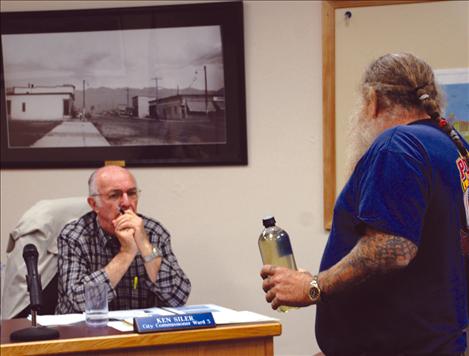Commissioners vote to build new wastewater facility
Hey savvy news reader! Thanks for choosing local.
You are now reading
3 of 3 free articles.
POLSON — At a special meeting on April 14, Polson City Commissioners voted unanimously to choose the membrane bioreactor system to improve the current sewer system and meet Department of Environmental Quality standards. The approximate cost of the system will be $18,334,800.
Mayor Heather Knutson asked the commission to change the order of the meeting, allowing the public to comment and to ask questions before the commissioners took their turn.
In his explanation, Polson Water and Sewer Superintendent Tony Porrazzo held a bottle of treated Polson wastewater and said, “This is what we’re doing.”
Pointing his hand at a photograph of Polson, Flathead Lake and the Mission Mountains, Porrazzo said, “And that’s what we’re protecting.”
Mark Shrives, Polson City Manager, said, “We’re at a critical point. We need to decide which way we are going so we can move forward with our grant applications.”
The first grant proposal is due May 2 with another grant hard on its heels on May 15.
Kevin Johnson, an engineer from DOWL HKM, an engineering firm, answered questions emailed to the city.
One of the questions was: if the City does not do a major upgrade, what options would it have to improve the current system?
Johnson said the headworks — the first place sewage goes in a wastewater treatment plant, where the trash, paper, plastic and grit are removed — and the disinfection effluent system would need to be constructed. The Environmental Protection Agency has mandated that the ultraviolet disinfection system be functional and meeting compliance criteria by the end of 2017.
The lagoon system is already having performance issues, Johnson said, and a UV system without other improvements would be a challenge.
Another question asked which choice was recommended and why. Johnson said that depends on “how well we can look into the crystal ball.” The EPA has mandated its standards for numeric nutrient criteria, that’s amounts of nitrogen and phosphorus that go into water, from state to state. Either system, the MBR or the Intermittent Cycle Extended Aeration System with filtration could meet what the State of Montana has established as currently written. The EPA recognizes the Confederated Salish and Kootenai Tribes as a state, and the tribe has not developed their numeric criteria yet, so the best guidance is the state numbers, Johnson said.
However, he thinks it’s possible the EPA will keep raising the standards.
Since three Polson citizens had questioned her, Commission Jill Southerland asked if there were other systems that could work for the wastewater system.
There are about 10 choices, Johnson said, but MBR rises to the surface with its integral filtration and solid separation.
Nutrient levels in Flathead Lake and the lower Flathead River used to be dealt with differently, Commissioner John Campbell said. He asked if the river standards would be as tough as the lake standards.
Polson City Engineer Shari Johnson said now the state is looking at the entire watershed, from the Upper Flathead River to Flathead Lake to the Lower Flathead River where it flows into the Clark Fork River. Although nothing is written down yet, Shari said indications are the levels won’t be any less stringent.
Commissioner Dan Morrison commented he’d read there was less room for people error with the MBR system and asked Kevin about this.
Kevin agreed, saying as far as the actual day-to-day work, the MBR was easier to operate.
Comparing the two systems, MBR and SBR with filtration system, Kevin said the membranes, where the flat-plate membranes live, have to be in a building. Originally the SBR choice was in a building, but to lower costs, just the bio treatment system is outside, with covers on top for odor control and weather issues.
To feed the liquid into the flat-plate membranes, Kevin said plans could call for lifting the water up so gravity can push it through, or, a permeate pump to pull water through the membranes.
Questioned about adding on to the systems, Kevin said the SBR’s tertiary filtration system would mean building more basins. The MBR system is built to be able to add additional filtration easily.
The membranes have a life of 10 to 12 years, and then they need to be replaced. The tentative MBR budget listed about $2 million in equipment costs from the manufacturer, instrumentation and controls, a couple of extra blowers to clean the membranes and half a dozen pumps.
“Between 25 to 50 percent (of the $2 million) was for membranes,” Kevin said, although the prices have come down drastically from 10 years ago, he noted.
Operators, employees of the city, will need more training so they can become Class 1 operators and will need to be retested, Commissioner Campbell said.
Commissioner Ken Siler asked if the treated water could be used for irrigation.
Since the effluent, or water, will be totally unrestricted, it can be used to water parks, etc.
The raise in rates “is what’s keeping me up at night,” said Commissioner Campbell.
He knows people who live on a fixed income, and an increase from an average overall sewer rate of $29 per month to $98.32 monthly will hit them hard.
“This body needs to come together to figure out how to take care of those people,” Campbell said.
Campbell suggested either the water department fund or non-profit organizations could help people struggling to pay their bills.
“That’s what killing me, those people on the lower end,” Campbell said.
Shari noted the increases could be done in stages. Until the loans are closed, the rates don’t have to be in place, she said. The commission will have had to pass an ordinance spelling out when and how the rates will be raised.
The next Polson City Commission meeting will be held May 21 at 7 p.m. at city hall.
















